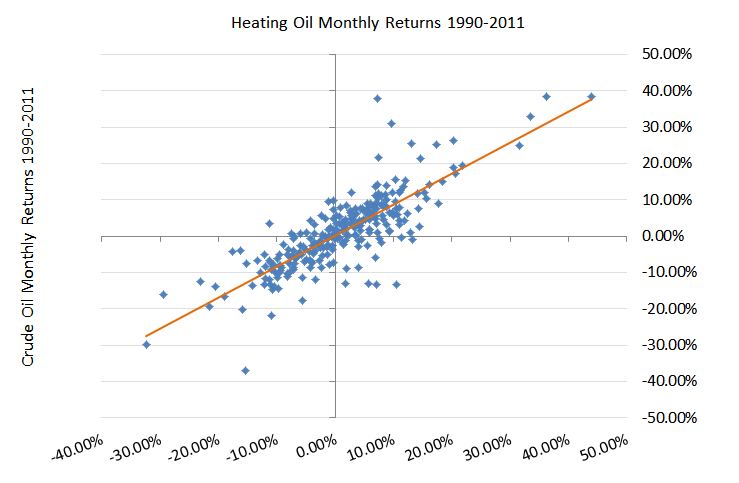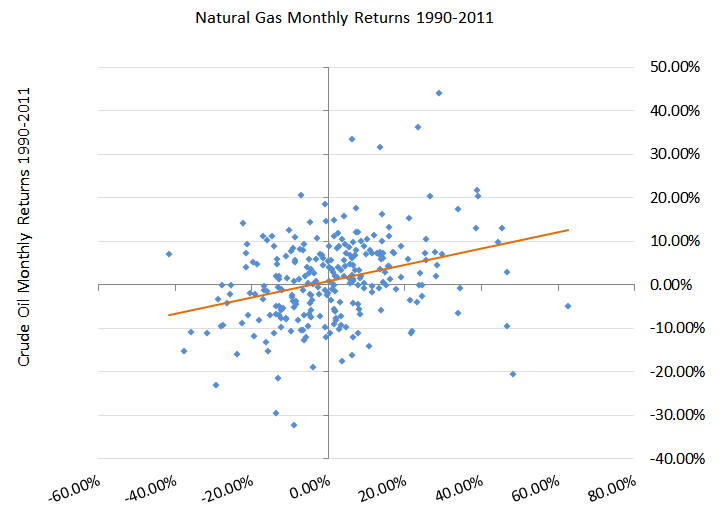Crude Oil, Natural Gas & Heating Oil
In the world of finance correlation is a statistical measure of how two securities move in relation to each other. Correlation is computed into what is known as the correlation coefficient, which ranges between -1 and +1. Perfect positive correlation (a correlation co-efficient of +1) implies that as one security moves, either up or down, the other security will move in lockstep, in the same direction. Alternatively, perfect negative correlation means that if one security moves in either direction the security that is perfectly negatively correlated will move in the opposite direction.
In the energy sector, Natural Gas, Crude Oil and Heating Oil prices are correlated. Though it is important to know the magnitude of the correlation between these commodities. Historical analysis of monthly returns have shown strong correlation between Heating Oil and Crude Oil. During the analyzed period between 1990 and 2011 crude oil and heating oil have shown strong correlation with 0.81 correlation co-efficient. During the same time period Natural Gas and Crude Oil have shown relatively weak correlation. Correlation was still positive with 0.31 correlation co-efficient. Monthly returns and their correlation can be seen on the figures below. Weak correlation between two instruments creates diversification opportunity. However, two closely correlated asset class or commodity would increase the risk in a portfolio.
Given the strong correlation between Crude Oil and Heating Oil, as the previous analysis suggests, one would expect a flat relative performance between the two commodities in the long-run. Relative performance (relative strength) is a measure of price trend that indicates how an index, commodity, stock or currency is performing relative to the other. I.e EUR vs. USD is the most common relative performance ratio that we follow everyday. It is the performance of EUR versus USD. It would have been great if we were to know that EUR/USD will trade between 1.10 and 1.30 in the next decade. During a period of 10 years we would have an edge by knowing when to sell EUR and when to buy USD.
After finalizing correlation study between the three energy commodities we search for relative strength patterns by calculating the ratio between Heating Oil and Crude Oil and also between Natural Gas and Crude Oil. Our findings show that we do actually have an edge to forecast the relative performance between each commodity. Heating Oil/Crude Oil ratio trades in a perfect range. 1993, 2000, 2003, 2008 and 2011 have been the peak levels for the ratio. At he peak levels Heating Oil was overvalued versus Crude Oil. 1995, 1999, 2002, 2004 and 2009 have been the bottom levels for the ratio. At bottom levels Heating Oil was undervalued versus Crude Oil. Knowing that Heating oil and Crude oil historically have 81% correlation and their relative performance ratio moves from one extreme to another should give us an edge. Heating Oil vs. Crude Oil shows cyclical behavior.
What about trending behavior? We know that Natural Gas and Crude Oil have 31% correlation. As a result their relative performance is not likely to be flat in the long run. Unlike the ratio between Heating Oil and Crude Oil, Natural Gas/Crude Oil ratio has shown trending behavior. 1990-2000 period shows positive relative performance, while 2000-2011 period shows negative relative performance for Natural Gas. Even though there has been spikes on the Natural Gas/Crude Oil ratio during the analyzed period, trends persisted.







